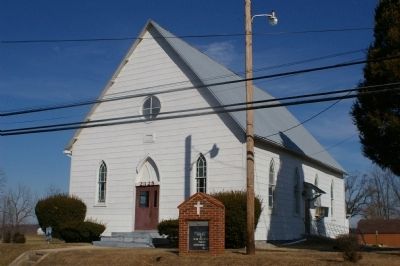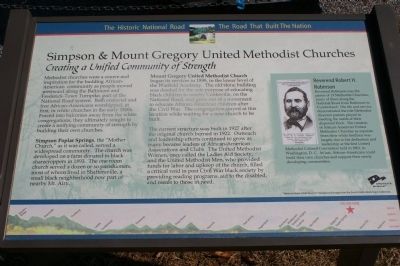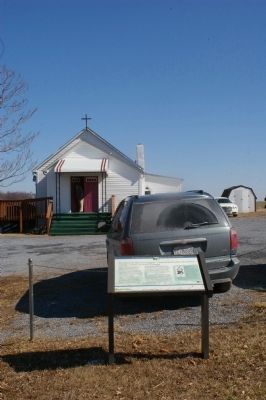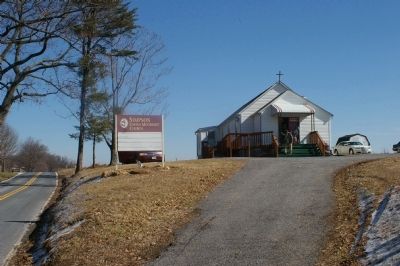Poplar Springs in Howard County, Maryland — The American Northeast (Mid-Atlantic)
Simpson & Mount Gregory United Methodist Churches
Creating a Unified Community of Strength
— The Historic National Road - The Road That Built The Nation —
Inscription.
Methodist churches were a source and inspiration for the budding African-American community as people moved westward along the Baltimore and Frederick-Town Turnpike, part of the National Road system. Both enslaved and free African-Americans worshipped, at first, in white churches in the early 1800s. Forced into balconies away from the white congregations, they ultimately sought to create a unifying community of strength by building their own churches. Simpson Poplar Springs, the “Mother Church,” as it was called, served a widespread community. The church was developed on a farm donated to black sharecroppers in 1893. The one room church served a dozen or so parishioners, most of whom lived in Shaffersville, a small black neighborhood now part of nearby Mt. Airy.
Mount Gregory United Methodist Church began its services in 1898, in the lower level of the Warfield Academy. The old stone building was deeded for the sole purpose of educating black children in nearby Cooksville, on the National Road, and grew out of a movement to educate African-American children after the Civil War. The congregation stayed at this location while waiting for a new church to be built.
The current structure was built in 1927 after the original church burned in 1922. Outreach and leadership efforts continued to grow as many became leaders of African-American Associations and Clubs. The United Methodist Women, once called the Ladies Aid Society, and the United Methodist Men, who provided funds for labor and upkeep of the church, filled a critical void in post Civil War black society by providing reading programs, aid to the disabled, and meals to those in need.
[Sidebar:]
Reverend Robert H. Robinson
Reverend Robinson was the pastor of 19 Methodist Churches, many of them along the National Road from Baltimore to Cumberland. His life and service demonstrated the role Methodist itinerant pastors played in meeting the needs of their dispersed flock. The creation of African-American United Methodist Churches as separate from their white brethren was largely due to his dedication and leadership at the first United Methodist Colored Convention held in 1861, in Washington, D. C. At last, African-Americans could build their own churches and support their newly developing communities.
Erected by America's Byways.
Topics and series. This historical marker is listed in these topic lists: African Americans • Churches & Religion • Roads & Vehicles. In addition, it is included in the The Historic National Road series list. A significant historical year for this entry is 1893.
Location. 39° 20.302′
N, 77° 6.101′ W. Marker is in Poplar Springs, Maryland, in Howard County. Marker is on Hardy Road, on the left when traveling west. The marker is at the west end of the parking lot for Simpson United Methodist Church. Touch for map. Marker is in this post office area: Mount Airy MD 21771, United States of America. Touch for directions.
Other nearby markers. At least 8 other markers are within 4 miles of this marker, measured as the crow flies. Poplar Springs (approx. 0.6 miles away); New Lisbon (approx. 1.8 miles away); Parrsville & Ridgeville (approx. 3.7 miles away); Riddlemoser Building (approx. 3.9 miles away); First Location of the Mount Airy School (approx. 3.9 miles away); The Nicodemus Building (approx. 3.9 miles away); Bobsled (approx. 3.9 miles away); Railway Express Agency Baggage Wagon (approx. 3.9 miles away).
More about this marker. In the sidebar is a portrait of Reverend Robert H. Robinson. The background of the marker is "National Road at Fairview Inn" which is the standard for markers in this series. An elevation diagram of the national road is displayed on the bottom of the marker's face.

Photographed By Christopher Busta-Peck, February 24, 2008
4. Mount Gregory United Methodist Church History
Church website entry
Click for more information.
Click for more information.
Credits. This page was last revised on May 1, 2022. It was originally submitted on February 25, 2008, by Christopher Busta-Peck of Shaker Heights, Ohio. This page has been viewed 1,891 times since then and 28 times this year. Photos: 1, 2, 3, 4. submitted on February 25, 2008, by Christopher Busta-Peck of Shaker Heights, Ohio. • Craig Swain was the editor who published this page.


